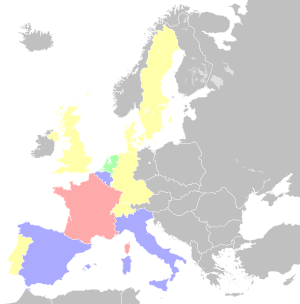
The 1980 Tour de France was the 67th edition of the Tour de France. The total distance was 3,842 km (2,387 mi) over 22 stages. In the first half of the race, Bernard Hinault started out strong by winning the prologue and two stages. However, knee problems forced Hinault to abandon the race while still in the lead. Joop Zoetemelk became the new leader, and defended that position successfully. Just as in 1979, when Hinault and Zoetemelk finished nearly a half hour ahead of the rest of the field, the 1980 edition was a battle between these two riders until Hinault abandoned. At the time Hinault was just 21 seconds ahead of Zoetemelk and the race was about to enter the Pyrenees. Zoetemelk did not wear the yellow jersey during stage 13 though he did in every stage thereafter finishing the race with nearly a seven-minute advantage over second place Hennie Kuiper. It was his first Tour victory in his tenth attempt, after already having finished second in five editions.

The 1994 Tour de France was the 81st edition of the Tour de France, one of cycling's Grand Tours. The Tour began on 2 July with a 7.2 km (4.5 mi) prologue around the French city Lille. After 21 more days of racing, the Tour came to a close on the street of the Champs-Élysées. Twenty-one teams entered the race that was won by Miguel Induráin of the Banesto team. Second and third respectively were the Latvian Piotr Ugrumov and the Italian rider, Marco Pantani.

The 1975 Tour de France was the 62nd edition of the Tour de France, one of cycling's Grand Tours. It took place between 26 June and 20 July, with 22 stages covering a distance of 4,000 km (2,485 mi). Eddy Merckx was attempting to win his sixth Tour de France, but became a victim of violence. Many French spectators were upset that a Belgian might beat the record of five wins set by France's Jacques Anquetil. During stage 14 a spectator leapt from the crowd and punched Merckx in the kidney. Frenchman Bernard Thévenet took over the lead. After Merckx subsequently fell and broke his cheekbone, he was unable to challenge Thévenet, who went on to win the Tour with Merckx second.

The 1966 Tour de France was the 53rd edition of the Tour de France, one of cycling's Grand Tours. It took place between 21 June and 14 July, with 22 stages covering a distance of 4,329 km (2,690 mi).

The 1971 Tour de France was the 58th edition of the Tour de France, one of cycling's Grand Tours. The 3,608-kilometre (2,242 mi) race consisted of 22 stages, including three split stages, starting in Mulhouse on 26 June and finishing at the Vélodrome de Vincennes in Paris on 18 July. There were three time trial stages and two rest days. Eddy Merckx of the Molteni team won the overall general classification, defending his title to win his third Tour de France in a row. Joop Zoetemelk (Flandria–Mars) finished second, 9:51 minutes behind, and Lucien Van Impe was third (Sonolor–Lejeune), just over 11 minutes in arrears.

The 1982 Tour de France was the 69th edition of the Tour de France, taking place from 2 to 25 July. The total race distance was 22 stages over 3,507 km (2,179 mi). It was won by Bernard Hinault, his fourth victory so far.

The 1978 Tour de France was the 65th edition of the Tour de France, one of cycling's Grand Tours. It took place between 29 June and 23 July, with 22 stages covering a distance of 3,908 km (2,428 mi).
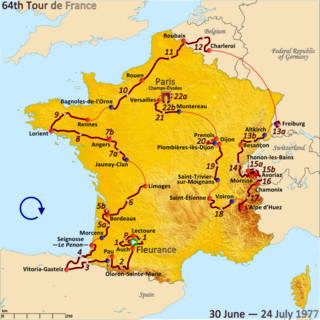
The 1977 Tour de France was the 64th edition of the Tour de France, taking place between 30 June and 24 July. The total race distance was 22 stages over 4,096 km (2,545 mi).

The 1974 Tour de France was the 61st edition of the Tour de France, one of cycling's Grand Tours. It took place between 27 June and 21 July, with 22 stages covering a distance of 4,098 km (2,546 mi). Eddy Merckx was attempting to win his fifth Tour de France in as many races.
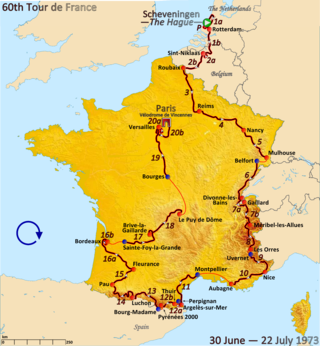
The 1973 Tour de France was the 60th edition of the Tour de France, one of cycling's Grand Tours. It took place between 30 June and 22 July, with 20 stages covering a distance of 4,090 km (2,541 mi). Eddy Merckx, winner of the previous four editions, did not start the 1973 Tour, partly to avoid angry French fans and partly to please his sponsor; instead he rode and won the 1973 Vuelta a España and the 1973 Giro d'Italia. In his absence, Luis Ocaña dominated the race by winning four mountain stages and two time trials. The result being a margin of victory exceeding 15 minutes.
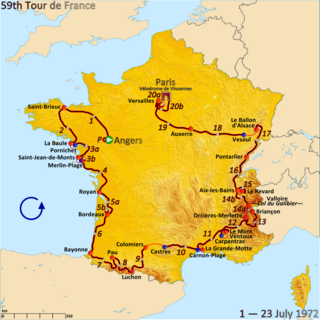
The 1972 Tour de France was the 59th edition of the Tour de France, one of cycling's Grand Tours. It took place from 1 to 22 July, with 20 stages covering a distance of 3,846 km (2,390 mi). After riding strongly in the first two weeks of the race and being the closest GC contender to Eddy Merckx, Luis Ocaña crashed, in the Pyrenees, leaving Merckx to battle Cyrille Guimard for the win. Guimard, having won four stages, had to leave the race after stage 17 in second place, but was given the combativity award after the race.

The 1970 Tour de France was the 57th edition of the Tour de France, one of cycling's Grand Tours. It took place between 27 June and 19 July, with 23 stages covering a distance of 4,254 km (2,643 mi). It was the second victory for Belgian Eddy Merckx, who also won the mountains classification, and nearly won every major jersey for a 2nd year in a row but finished second in the points classification behind Walter Godefroot by five points. The previous year only one rider was able to keep him within 20:00 and in 1970 a mere four other riders were within 20:00, with only debutant Joop Zoetemelk finishing inside 15:00 of Merckx.
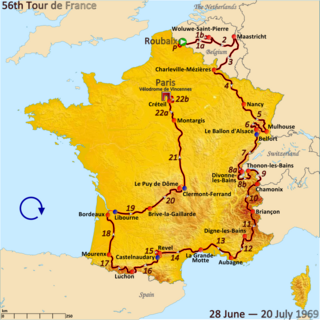
The 1969 Tour de France was the 56th edition of the Tour de France, one of cycling's Grand Tours. It took place between 28 June and 20 July, with 22 stages covering a distance of 4,117 km (2,558 mi). The participant teams were no longer national teams, but were once more commercially sponsored. The race was won by Eddy Merckx who absolutely dominated the rest of the field. As an example in 1967 nine riders finished within 20:00 of the winner, in 1968 nineteen riders were within 20:00 but in 1969 the 10th place rider was +52:56, the 20th place rider was +1:17:36 and only Roger Pingeon finished inside 20:00 of Merckx.

The 1968 Tour de France was the 55th edition of the Tour de France, one of cycling's Grand Tours. It took place between 27 June and 21 July, with 22 stages covering a distance of 4,492 km (2,791 mi). Eleven national teams of 10 riders competed, with three French teams, two Belgian teams and one from Germany, Spain, the United Kingdom, Italy, the Netherlands, and a combined Swiss/Luxembourgian team.
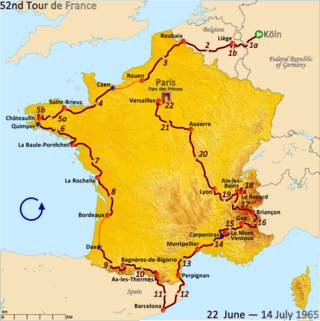
The 1965 Tour de France was the 52nd edition of the Tour de France, one of cycling's Grand Tours. It took place between 22 June and 14 July, with 22 stages covering a distance of 4,188 km (2,602 mi). In his first year as a professional, Felice Gimondi, a substitute replacement on the Salvarani team, captured the overall title ahead of Raymond Poulidor, the previous year's second-place finisher.

The 1959 Tour de France was the 46th edition of the Tour de France, taking place between 25 June and 18 July. The race featured 120 riders, of which 65 finished. The Tour included 22 stages over 4,358 km (2,708 mi).

The 1963 Tour de France was the 50th instance of that Grand Tour. It took place between 23 June and 14 July, with 21 stages covering a distance of 4,138 km (2,571 mi). Stages 2 and 6 were both two part stages, the first half being a regular stage and the second half being a team or individual time trial.

The 1961 Tour de France was the 48th edition of the Tour de France, one of cycling's Grand Tours. It took place between 25 June and 16 July, with 21 stages covering a distance of 4,397 km (2,732 mi). Out of the 132 riders who started the tour, 72 managed to complete the tour's tough course. Throughout the 1961 Tour de France, two of the French national team's riders, André Darrigade and Jacques Anquetil held the yellow jersey for the entirety 21 stages. There was a great deal of excitement between the second and third places, concluding with Guido Carlesi stealing Charly Gaul's second-place position on the last day by two seconds.
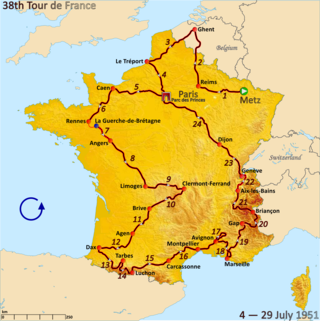
The 1951 Tour de France was the 38th edition of the Tour de France, taking place from 4 to 29 July. It consisted of 24 stages over 4,690 km (2,914 mi). The race started outside Île-de-France for the first time since 1926; a change that remained permanent beyond 1951 with the exceptions of 1963, 1983, 1984, 1986 and 2003.
The 1971 Critérium du Dauphiné Libéré was the 23rd edition of the cycle race and was held from 18 May to 23 May 1971. The race started in Avignon and finished at Montceau-les-Mines. The race was won by Eddy Merckx of the Molteni team.
